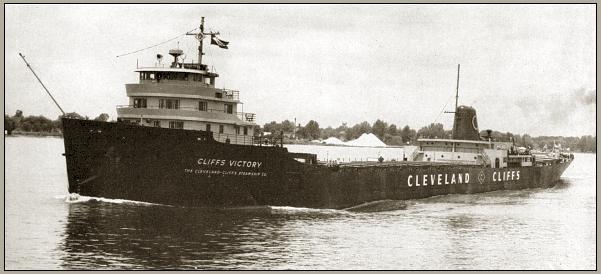
Inland Marine Communications - Overview

Cliffs Victory in 1953 - FCC Call Letters WD-5645 Waterways Magazine Photo
The "big" high-seas ship-to-shore radiotelephone stations WOO, WOM, WLO, and KMI received most of the attention during the marine radio heyday. However, the Great Lakes stations which served the lakes' bulk-carriers and freighters and the inland rivers stations which served the towboats on the Mississippi, Ohio, Tennessee, Monongahela, Ten-Tom, etc. were seemingly viewed as "second class." It's certainly clear that the FCC initially had this view as draconian frequency sharing was imposed on them until late in the era. I had no occupational connection to marine radio, but I was a frequent listener to the "tow" and "laker" stations. They were never, "second class," to me as I found the traffic on them far more interesting than the high-seas ship passengers' radioelephone calls made through the "big stations." Thus, I bring a shortwave listeners limited perspective to this endeavor, but contributions by those in the industry have corrected most of my misconceptions.
CW on the lakes goes back to 1910, and perhaps slightly earlier. There were many CW stations on the lakes in the years prior to 1935. The CW Page has information on Great Lakes CW stations as early as 1910, and predecessors of WLC at Rogers City were using CW in 1922. WMI at Lorain, OH initiated radiotelephone for the lakes in the mid-1930s. While there must have been CW used for commercial river communications as WGK listed CW frequencies in 1946, it was WJG, Memphis that really got river communications going via radiotelephone service in 1936 (FCC licensed in 1939). During the period from the mid 1940s to the mid 1970s AM (amplitude modulated) and later SSB (single sideband) ship-to-shore radiotelephone was the communications mode of choice for the lakes and rivers vessels.
The little Marine Radiotelephone Service pamphlets produced by AT&T contained maps that showed the city locations of the stations. Taken together these maps show some of the changes in the operational status of the stations serving the US including those serving the lakes and rivers. There are 7 of these covering the period from the late 1950s to the early 1980s. They, and other maps, can be viewed from the Maps page.
Marine Radio was a very important part of the FCC's responsibilities in the early years and the FCC Annual Reports contain considerable information of significance to inland marine radio. I have extracted much information from these reports, and the results through 1955 can be viewed here Unfortunately, as the years progressed the reports contain less and less about the activation or deactivation of individual stations. I believe that the FCC limited the power of all the Class II-B Public Coast Stations to 1KW and the shipboard stations to 150W. Up until about 1948 all the boats had four letter call signs; after that the FCC began to assign call signs that consisted of two letters followed by four numbers.
The best information I have indicates that during the HF radiotelephone era there was one emission type change (AM to SSB), and three frequency changes. The table below attempts to date these changes. This listing of the 2 MHz marine stations is from the February 1961 issue of Popular Electronics. In the 1980s Monitoring Times published a marine frequency listing by Jim Hays. This listing corresponds to the second (or third) line in the table below.
| TYPE OF CHANGE | DATE |
| ITU Mandated Frequency Realignment | 07/91 |
| River/Lakes Stations Get More Channels | Before 02/81 |
| Another frequency change - When? | Late 1970s? |
| Conversion from AM to SSB Complete | ?? |
| FCC no longer licenses AM | 01/01/1972 |
| ITU Mandated Frequency Realignment | 1954 |
| RMCA Repot on 1937 Comm. Law Changes | 05/20/1937 |
I have lived through 5 iterations in towboat communications. AM MF/HF in the 1930s - 60s, SSB HF in the 60s- 90s, VHF-FM in the 60s - 90s, Watercom in the 80s- 2000s and satellites and cellphones since. The satellite comms. allowed PCs in the pilot house which greatly reduced the need for voice communications much of which is now via cell phone. The exception is the continuing use of VHF-FM for boat-to-boat and boat-to-lock comms. The thecnology advances caused the demise of Watercom the last towboat-to-shore communications system making use of FCC allocated marine frequencies.